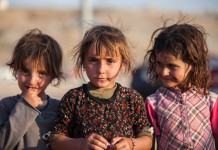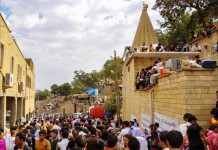
Ezidis from all over the world have welcomed the arrival of their New Year. On New Year´s eve, the Ezidi communities of Georgia, Armenia, the USA as well as Canada held ceremonies and celebrations to start into the New Year. The Ezidi New Year, also called Red Wednesday (Charshema Sor), falls on the first Wednesday of April under the Julian calendar and is one of the oldest celebrations of the Ezidis and the Middle East. It is at the same time known as the spring festival that is supposed to ring in the reblooming nature.
The main festivities, as in every year, take place at the central sanctuary Lalish in northern Iraq, near the Kurdish town of Dohuk. The mood, however, will be clouded by the genocide perpetrated against the Ezidis in Shingal by the Islamic State and the ongoing enslavement of thousands of women and children. The New Year celebrations will therefore be in many places less extensive than usual. Ezidi refugees from the camps of northern Iraq´s Kurdish region have nevertheless dyed eggs and baked bred to celebrate under modest conditions.
New Year celebrations in Georgia
On Red Wednesday, according to the Ezidi mythology, God finished the creation of the world and the first sunbeams reached the Earth. The firfament began to turn red – which is one reason for the name´s derivation. The coloured eggs recall the great pearl (Dur) from which the material being was created while the New Year also represents the spirit of the uppermost of the seven archangels Tawus Melek who constitutes the core philosophy of the religion.
No weddings are held during the month of April. People are, moreover, asked not to farm the land, so that nature can recover. Many customs are associated with the Ezidi New Year which has close parallels with the Babylonian Akitu festival. In Lalish, people light thousands of candles called Jira during the evening to receive the New Year. In Germany, associations usually organize events where Ezidis come together and celebrate.
© ÊzîdîPress, 20. April 2016




























